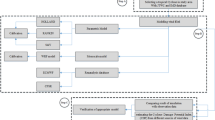Abstract
An extended range tropical cyclogenesis forecast model has been developed using the forecasts of global models available from TIGGE portal. A scheme has been developed to detect the signatures of cyclogenesis in the global model forecast fields [i.e., the mean sea level pressure and surface winds (10 m horizontal winds)]. For this, a wind matching index was determined between the synthetic cyclonic wind fields and the forecast wind fields. The thresholds of 0.4 for wind matching index and 1005 hpa for pressure were determined to detect the cyclonic systems. These detected cyclonic systems in the study region are classified into different cyclone categories based on their intensity (maximum wind speed). The forecasts of up to 15 days from three global models viz., ECMWF, NCEP and UKMO have been used to predict cyclogenesis based on multi-model ensemble approach. The occurrence of cyclonic events of different categories in all the forecast steps in the grided region (10 × 10 km2) was used to estimate the probability of the formation of cyclogenesis. The probability of cyclogenesis was estimated by computing the grid score using the wind matching index by each model and at each forecast step and convolving it with Gaussian filter. The proposed method is used to predict the cyclogenesis of five named tropical cyclones formed during the year 2013 in the north Indian Ocean. The 6–8 days advance cyclogenesis of theses systems were predicted using the above approach. The mean lead prediction time for the cyclogenesis event of the proposed model has been found as 7 days.






Similar content being viewed by others
References
Bougeault P, Toth Z, Bishop C, Brown B, Burridge D, Hui Chen D, Ebert B, Fuentes M, Hamill TM, Mylne K, Nicholau J, Paccagnella T, Park Y-Y, Parsons D, Raoult B, Schuster D, Silva Dias P, Swinbank R, Takeuchi Y, Tennant W, Wilson L, Worley S (2010) The THORPEX Interactive Grand Global Ensemble (TIGGE). Bull Amer Meteorol Soc 91:1059–1072
Brunet G et al (2010) Collaboration of the weather and climate communities to advance sub-seasonal to seasonal prediction. Bull Am Meteorol Soc 91:1397–1406. doi:10.1175/2010BAMS3013.1
Chelton DB, Schlax MG, Freilich MH, Milliff RF (2004) Satellite measurements reveal persistent small-scale features in ocean winds. Science 303(5660):978–983
Frank NL, Husain SA (1971) The deadliest tropical cyclone in history. Bull Amer Meteor Soc 52:438–445
Fu X, Hsu PC (2011) Extended-range ensemble forecasting of tropical cyclogenesis in the northern Indian Ocean: modulation of Madden–Julian oscillation. Geophys Res Lett 38(L15803):2011. doi:10.1029/2011GL048249
Goerss JS (2000) Tropical cyclone track forecasts using an ensemble of dynamical models. Mon Weather Rev 128:1187–1193
Jaiswal N, Kishtawal CM (2011) Prediction of tropical cyclogenesis using scatterometer data. IEEE Trans Geosci Remote Sens 49(12):4904–4909
Jaiswal N, Kishtawal CM, Pal PK (2012) Prediction of tropical cyclogenesis in North Indian Ocean using Oceansat-2 scatterometer (OSCAT) winds. Meteorol Atmos Phys. doi:10.1007/s00703-012-0230-8
Katsaros KB, Forde EB, Chang P, Liu WT (2001) QuikSCAT’s sea winds facilitates early identification of tropical depressions in 1999 hurricane season. Geophys Res Lett 28(6):1043–1046
Krishnamurti TN, Kishtawal CM, Zhang Z, LaRow T, Bachiochi D, Williford E, Gadgil S, Surendran S (2000) Multimodel ensemble forecasts for weather and seasonal climate. J Climate 13:4196–4216
Li T, Fu B, Ge X, Wang B, Peng M (2003) Satellite data analysis and numerical simulation of tropical cyclone formation. Geophys Res Lett 30(21):2122
Liu G, Curry JA, Clayson CA (1995) Study of tropical cyclogenesis using satellite data. Meteorol Atmos Phys 56(1/2):111–123
Majumdar SJ, Finocchio PM (2010) On the ability of global ensemble prediction systems to predict tropical cyclone track probabilities. Weather Forecast 25:659–680
Richardson D, Buizza R, Hagedorn R (2005) First workshop on the THORPEX interactive grand global ensemble (TIGGE). Tech Rep, WMO World Weather Research Programme, Reading, UK, pp 1–39. http://www.wmo.int/pages/prog/arep/wwrp/new/documents/TIGGEFirstWorkshopReport.pdf.
Sharp RJ, Bourassa MA, O’Brien JJ (2002) Early detection of tropical cyclones using SeaWinds-derived vorticity. Bull Amer Meteorol Soc 83(6):879–889
Vitart FE (2006) Seasonal forecasting of tropical storm frequency using a multi-model ensemble. Q J R Meteorol Soc 132:647–666
Wang L, Lau KH, Fung CH, Gan JP (2007) The relative vorticity of ocean surface winds from the QuikSCAT satellite and its effects on the geneses of tropical cyclones in the South China Sea. Tellus Ser A 59(4):562–569
Wang L, Lau KH, Zhang QH, Fung CH (2008) Observation of nondeveloping and developing tropical disturbances over the South China Sea using SSM/I satellite. Geophys Res Lett 35:1–5
Yamaguchi M, Majumdar SJ (2010) Using TIGGE data to diagnose initial perturbations and their growth for tropical cyclone ensemble forecasts. Mon Weather Rev 138:3634–3655
Zehr RM (1988) Satellite diagnosis of tropical cyclones. In: Proceedings 3rd conference satellite meteorology oceanography, Anaheim, CA, pp 241–246
Zhang Z, Krishnamurti TN (1997) Ensemble forecasting of hurricane tracks. Bull Amer Meteor Soc 78:2785–2795
Acknowledgments
The authors are thankful to the THORPEX Interactive Grand Global Ensemble (TIGGE) (http://tigge-portal.ecmwf.int) for providing the free access to the global model output.
Author information
Authors and Affiliations
Corresponding author
Additional information
Responsible Editor: M. Kaplan.
Rights and permissions
About this article
Cite this article
Jaiswal, N., Kishtawal, C.M., Bhomia, S. et al. Multi-model ensemble-based probabilistic prediction of tropical cyclogenesis using TIGGE model forecasts. Meteorol Atmos Phys 128, 601–611 (2016). https://doi.org/10.1007/s00703-016-0436-2
Received:
Accepted:
Published:
Issue Date:
DOI: https://doi.org/10.1007/s00703-016-0436-2




